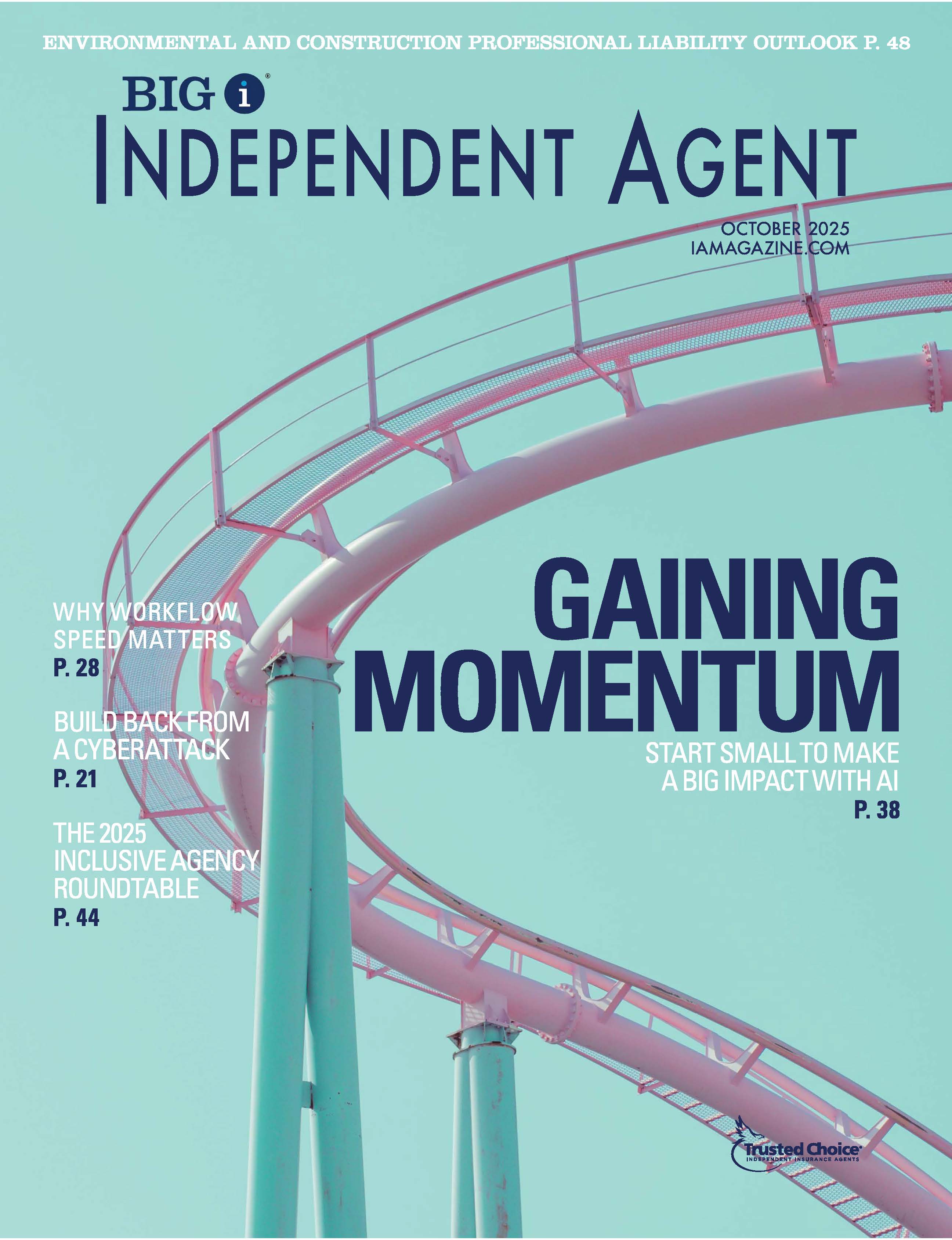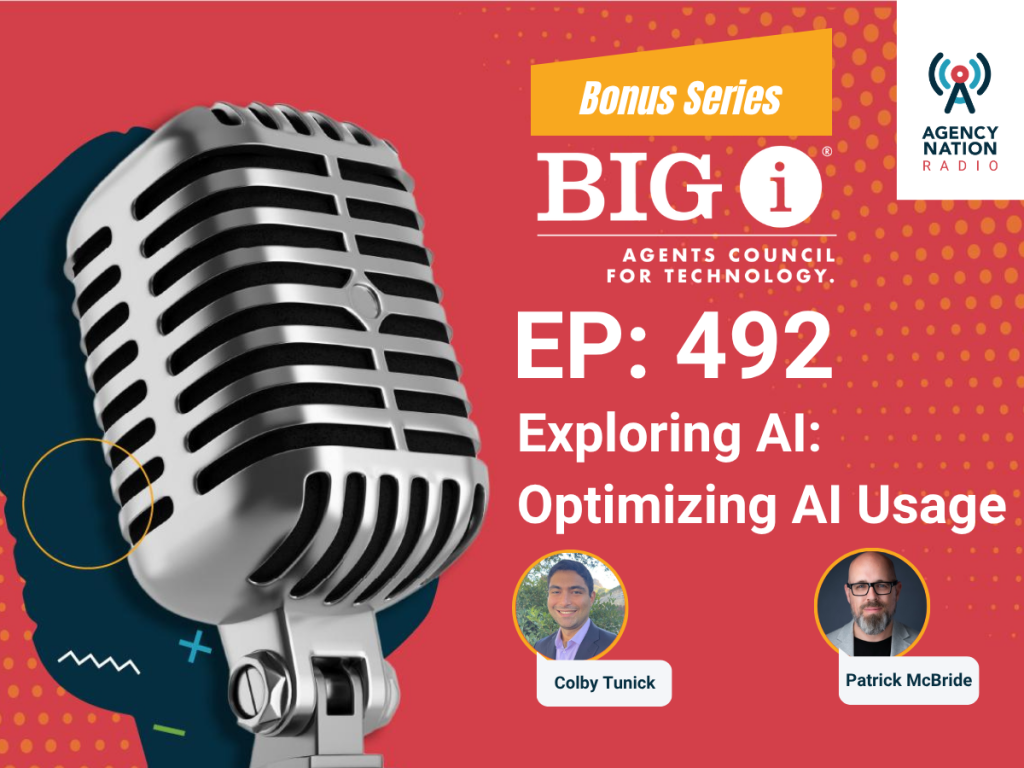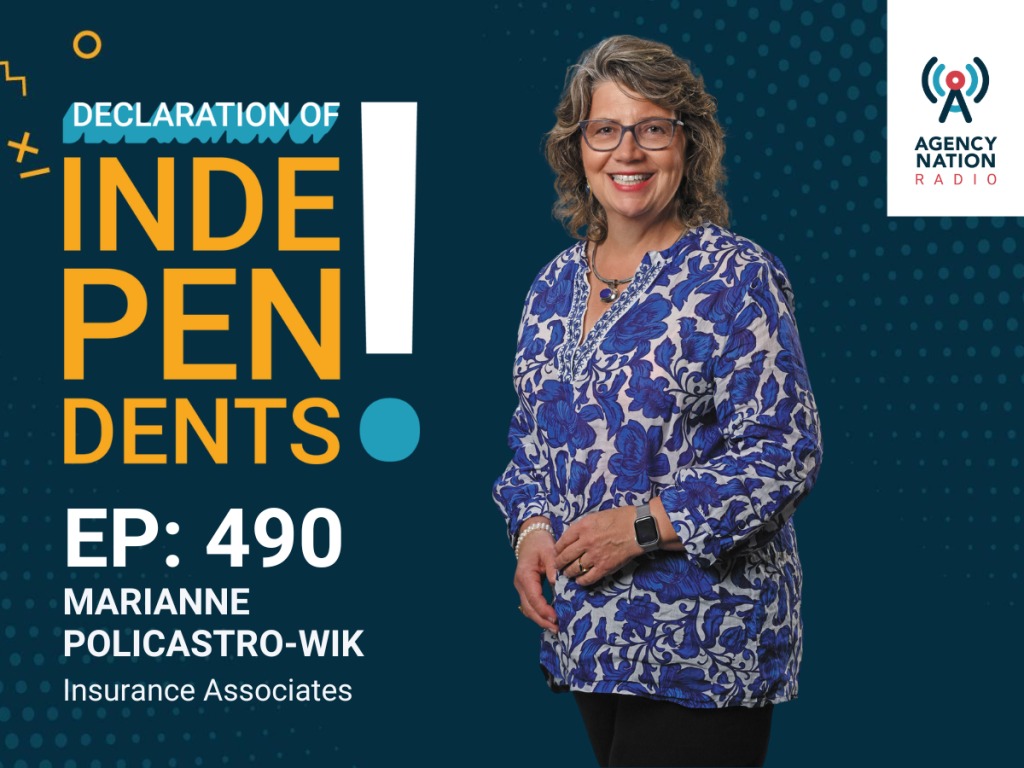Aim Higher: 8 Ways Independent Agents Can Use AI to Increase Productivity and Profitability

By: AnneMarie McPherson Spears
Independent agents, meet your new best friend: artificial intelligence.
“New” is a mislabel, actually. AI has existed since the 1950s and we’ve been talking for some time about how this technology has been implemented in areas such as chatbots on agency websites or in underwriting. However, the release of Open AI’s ChatGPT last November dialed up the hype to 11.
ChatGPT, which stands for chat generative pre-trained transformer, broke existing records by reaching 100 million users two months after its launch—for context, it took TikTok about nine months to do the same, Reuters reported.
While the initial hype may be winding down, with ChatGPT’s visits slowing with a 9.7% drop from May to June, according to data analytics firm Similarweb, generative tools like ChatGPT are only the tip of the iceberg.
In the insurance industry alone, AI was valued at $3.64 billion in 2022 and is forecast to reach $35.77 billion by 2030, a compound annual growth rate of 33.6%, according to Data Bridge Market Research. And in a survey of insurers from research and advisory firm Celent, respondents shared that 10% had large language models (LLMs) in production and 50% shared that they expected to either have something in a test phase or in production by the end of the year.
“AI will significantly impact the independent agency channel,” says Ilya Filipov, general manager at Total Expert. “Overall, these advancements will revolutionize the insurance industry, enabling them to scale what they do with ease, taking away effort spent on mundane tasks from agencies and their producers, while allowing them to focus on what they care for the most—their clients.”
These tools offer productivity, more informed decision making, and smoother customer service—what’s not to like?
Not So Fast
With great power comes great responsibility. The poster child for AI pop culture, ChatGPT is facing two lawsuits—at the time of publication—from creators alleging OpenAI’s unlawful use of copyrighted material. The Federal Trade Commission has also launched an investigation into the bot’s generation of false statements about real people. And companies like Apple, Spotify and Verizon have outright banned their employees from using it at work over concerns about sensitive data being disseminated.
Every AI solution comes with some caveats for use in an agency. “One concern is data security and privacy,” says Sean Erikson, vice president of enterprise architecture, IT strategy, emerging tech and enterprise automation at Grange Insurance. “AI relies heavily on data, and with the increase in digital reporting and processing, there’s a greater need to safeguard sensitive customer information.”
LLM AI programs like ChatGPT have been known to “hallucinate,” or generate false information, and Rich Belanger, chief technology officer at Applied, warns about using LLMs when predictive AI is more appropriate for independent insurance agencies.
“You have to be a little careful with the LLMs when it comes to agency management and operations, with their tendency to hallucinate,” he says. “The LLMs are getting a lot of press right now, but predictive AI tools have been out for quite a while and are really good at identifying patterns and data and helping with operational management.”
 But if you are using an LLM, it’s important to “keep a human in the loop,” says Elliot Bassett, president of Ellerbrock-Norris in Omaha, Nebraska. “You should always have a human asking, ‘Is this accurate?’ and ‘Does it make sense for the client?'”
But if you are using an LLM, it’s important to “keep a human in the loop,” says Elliot Bassett, president of Ellerbrock-Norris in Omaha, Nebraska. “You should always have a human asking, ‘Is this accurate?’ and ‘Does it make sense for the client?'”
Additionally, every AI algorithm is susceptible to bias based on erroneous assumptions in the machine learning process. “It’s critical to ensure AI models are regularly monitored and audited to identify those errors, and agents need to be vigilant in verifying AI-generated outputs,” Erikson says.
In August, the first lawsuit brought by the U.S. Equal Employment Opportunity Commission (EEOC) for bias using AI software was settled, as reported by Insurance Journal. The lawsuit alleged that China-based tutoring company ITutorGroup Inc. had used AI software that discriminated against older job applicants. ITutorGroup agreed to pay $365,000 to more than 200 job applicants.
The National Association of Insurance Commissioners (NAIC) released in July a model bulletin on regulatory expectations for the use of AI systems by insurers. The model bulletin was open for comments until Sept. 5, but urged insurers to implement protocols to address “governance, risk management controls, internal audit functions and third-party AI systems,” according to the bulletin.
And, of course, the elephant in the room: Will AI replace agents?
Everyone loves to say the emerging technology du jour will be the extinction event for agents, even as direct writers that attempted to eliminate the role of agents have failed to take over the world, and even though the independent agency channel continues to make steady gains in lines of business penetration, according to the Big “I” 2023 Market Share Report.
“Everyone loves the doomsday headline, the doomsday here being job losses,” says Marcus Daley, technical co-founder of NeuralMetrics. “I think AI is deflationary, meaning there are jobs that will go away—but it’s only deflationary for those people who don’t change and learn how to use the technology for the problem they’re trying to solve.”
“You’ve got to keep swimming,” he continues. “If you want to stay employed, you need to learn about this change and go with it. If I were an agent, I would want to be in an agency that is first to go try things out, not last. Because it’s really painful when you’re last and you’re being forced to turn.”
Taking initiative on AI implementation is key to growth, agrees CJ Hutsenpiller, team leader at Hutsenpiller Insurance in Mt. Juliet, Tennessee. “Five years from now, there will be such a gap between the haves and the have-nots,” he says. “Some people want to get a million-dollar book and live off the renewals, and that’s fine. But for the agencies that are trying to grow, using AI will give them a ridiculously big advantage over those who aren’t.”
Hutsenpiller Insurance began implementing AI in 2018. “Our first AI tool was chatbots, but they were very basic,” Hutsenpiller says. “They had a bit of conditional logic and knowledge, but nothing like what is available now. Most of our really cool stuff began when OpenAI became publicly available.”
“We’ve implemented AI into pretty much every process where it makes sense,” he says. The agency uses AI programs to make transcriptions of calls and drop the meeting notes into the agency management system (AMS), analyze its book of business to improve the renewal process, and reconcile the agency’s commissions and bank statements.
“AI should be used to give your team superpowers,” he says. “Not to replace them, but to enhance them and make them better.”
“Whether it’s AI or any tech, it seems like it often gets viewed as a threat, and I think that’s just the wrong lens to look at things through,” agrees Andy Bassett, CEO of Ellerbrock-Norris. “Don’t look at AI as a threat, embrace it as the tool that it is.”
In addition to incorporating AI tools into its agency in sales, marketing, producer training and more, Ellerbrock-Norris founded LAUNCH, an assessment-based sales tool that the team has begun implementing AI into as well.
“The independent agency system is unique in that we’ve got the agency distribution channel and the insurance carrier partners, and AI is able to bridge that gap, bring that process closer together and make it more seamless,” Andy Bassett says. “If we can continue to streamline that process to give the consumer the best access, that’s a tremendous value to any tech and especially AI.”
For independent agents, AI is not just inevitable, it will also make their lives easier—and isn’t it nice when those overlap?
8 Ways AI Can Supercharge Your Agency
Agencies that proactively learn about and incorporate AI-enabled tools into their tech strategy will have the edge. With caveats and cautions firmly in place, here are eight ways the independent agency channel can harness AI for productivity and profitability:
1) Marketing
Marketing is the low-hanging fruit of AI implementation. “I see a lot of agencies trying to incorporate AI into their process of sales and marketing,” says Brad Ruben, president of Archway Computer. “Having a ChatGPT log in and using it is an important first step. It solves the blank page problem. Ask it questions, have it create results, and then refine them.”
With ChatGPT, “the easiest thing is to plug in a sentence like, ‘Write a blog post of five reasons why people might want to insure their boat,’ and it will write a piece for you—and that’s the lowest thing it can do,” says Beth Z, founder of Your Nerdy Best Friend. “After that you can say, ‘Now divide it up into five tweets.’ ‘Now divide it up into captions for social media posts.'”
It’s important to not stop there though. In addition to verifying the facts ChatGPT oh-so-confidently spits out, you’ll need to refine and edit the results. “Another tip is to capture your own style by having ChatGPT analyze your work, and then ask it to apply your style to a prompt,” Beth Z says. “The first iterations are always going to be incredibly generic.”
Already, “products like HubSpot are incorporating AI, so if someone responds to an email you sent through the platform, AI can run through natural language processing to spit an answer back out,” Ruben says. “Being able to say, ‘I want this email to be witty,’ or ‘I want it to reflect what’s going on in the Boston area,’ has been really helpful.”
Applied has incorporated OpenAI’s application programming interface (API) into its Slack workspace, allowing employees to use ChatGPT. “Anyone can go into Slack and ask a question or use the tool to write a job description or write copy,” Belanger says.
AI in marketing doesn’t stop at content generation. “AI can segment customers based on their profiles and behaviors, allowing agents to create personalized marketing sales campaigns and target offers,” Filipov says. “An agent could create lists of clients that are more prone toward bundling their policies, or those who might own a small business—all of which enables an agent to take an individualized approach instead of a spray-and-pray one.”
Hutsenpiller integrated an AI tool to automatically reply to Google reviews. “My Achilles heel was replying to Google reviews,” he said. “We get seven to 10 a week and I would always forget to respond. So now we have AI that responds to our Google reviews in real-time with a customized response.”
2) Sales
Agencies sit on vast amounts of data in their AMS. “AI can take those vast amounts of customer data to identify patterns, preferences, and trends,” Filipov says. “AI can create predictive models for customer churn, policy renewals, claim likelihood, market fit and more.”
Currently, agents would integrate predictive AI capabilities in their AMS through an API either from the AMS vendor or a third party if the AMS has open API capabilities. Alternatively, agents could use a flat file of customer data that is downloaded into a third-party system, Filipov explains.
“In the long-term, they would also be able to take into account carrier underwriting guidelines, but those are not necessarily here yet because of the legacy systems many carriers operate with,” he adds.
For now, “providers are going to be increasingly adding AI directly into AMS workflows,” Belanger says. “In many cases, automated policy checking is already integrated with their systems so they can take a look at policies and highlight differences.”
 The ability to quickly compare policies is also valuable for errors & omissions mitigation when moving clients between carriers. “There are so many little nuances between carriers, and it can be an E&O exposure,” Hutsenpiller says. “We can compare the contracts and AI can point out the differences, and from there we can make a checklist of the items we need to talk about with the customer.”
The ability to quickly compare policies is also valuable for errors & omissions mitigation when moving clients between carriers. “There are so many little nuances between carriers, and it can be an E&O exposure,” Hutsenpiller says. “We can compare the contracts and AI can point out the differences, and from there we can make a checklist of the items we need to talk about with the customer.”
In addition to Ellerbrock-Norris giving its entire team access to ChatGPT so they can use it to come up with policy and coverage explanations, “we’ve taken it a step further and we’re building it into some custom software we have,” Elliot Bassett says. “It will help us analyze the risk profile of a client and then recommend potential risk management solutions. We’re also playing around with abilities to read policy documents, so you could ask the software, ‘What are the exclusions in this policy, what do they mean, and how does that impact my client?'”
Hutsenpiller Insurance uses AI heavily in its renewal processes, especially for retention. “We allow AI to analyze our book and make predictions on which accounts are at high risk of leaving the agency versus those that aren’t, which saves us time, especially with the way the market is right now,” Hutsenpiller says. “We’re not having to re-shop every single account, we’re simply going by what the AI tells us to look at.”
“Our retention has actually gone up two points since we’ve started doing this,” he adds.
Not only can AI help agents make sales more efficient, it can also make agents more efficient when selling. “A lot of workflows are very complex and clicky,” Belanger says. “Just think if you had an AI companion that could help you understand the choices you’re making and the next best thing you can do throughout your day? I think we’re going to see many providers work to enhance workflows in the AMS.”
3) Customer Service
Chatbots are old news, but thanks to groundbreaking LLM progress, they can be more helpful than ever before. “AI-driven chatbots will be powered by deep neural networks,” Filipov says. “The chatbot can take the repetitive, simple requests and free the customer service representative to focus on the customers who need more of a personalized approach.”
An AI program listens to and transcribes every phone call in Hutsenpiller Insurance, and then places a summary automatically in the notes section of the AMS. “On top of that, it monitors tone,” Hutsenpiller says. “If there’s a big altercation on a call, the AI would detect that and actually notify management, which cues us to look at the interaction a little closer and fix a problem before it grows.”
4) Producer Training
“In an industry that’s thirsting for an advisory model, AI is a tremendous tool to be able to support a younger or newer advisor who wants to adopt that model but doesn’t have the experience to talk about broader risk with a business owner versus simple insurance product placement,” Andy Bassett says.
Elliot Bassett emphasizes AI in producer training to help new hires reach producer validation, which is when an agent’s production as measured by commission is equal to the cost of paying them.
The Best Practices Study, conducted by the Big “I” and Reagan Consulting, measures net unvalidated producer payroll (NUPP) as the product of an agency’s investment in unvalidated producers and success rate in hiring producers. It is “the best overall measure of an agency’s effectiveness in recruiting and developing sales talent,” the study says, noting that the success of young producers is key for perpetuation.
However, young producer success is a struggle among smaller agencies in particular—even the top ones. Among 2022 Best Practices Agencies with less than $1.25 million in revenue, 66% of the group’s book of business is controlled by producers older than 45, according to the study.
But with easy access to AI tools, even small agencies can have a shot at improvement. “One of the biggest hurdles facing agencies is that we’re going to have to attract sales talent to the industry,” Elliot Bassett says. “It’s very difficult to train a green producer. I think the acceleration of getting a producer from day one to producer validation is one of the biggest impacts AI can have. You can create training programs, you can create role-playing scenarios, and then have that person interact with the AI to get them further down the road quicker.”
“You can accelerate that learning curve, which can be really advantageous for agencies, their employees, and of course their end customers,” Belanger agrees, adding that “if agency employees are getting up to speed on how they can do their jobs, it eliminates a percentage of E&O risk.”
And if a seasoned producer wants to start a new niche, “AI will make it easier for them to scale, or get up to speed in a specialty area,” Belanger says.
5) Risk Management
In Ellerbrock-Norris’ LAUNCH software, “we provide the simple ability to walk through an assessment with the client, and a consistent way to get answers, after which the system will score the risk profile,” Elliot Bassett says. “We’re implementing AI on the back end so agents can then ask, ‘Tell me what risks they should be concerned about,’ or ‘What’s the highest likelihood of a negative impact on their finances?’ That’ll allow us to personalize insurance policies to the client.”
The ability to get consistent answers when analyzing risk is key, Daley says. “Anytime you can get to ‘yes’ or ‘no’ answers is helpful,” he explains. “Do they have a swimming pool? Is their business open 24 hours a day? There is no bias; those are just facts. Perhaps you factor in weather data, perhaps you factor in that they traveled from here to there.”
“Of course, it can get difficult, because when you initiate personalization, you start to get into data points that aren’t there, or the databases are not easy to access or expensive to access,” he adds. “What data points can you factor in that are unique to specific businesses, and how can you capture risk data in a way that doesn’t encroach on their privacy?”
One example Daley gives is, in a lessor’s risk product, “we are able to know what other tenants are in the building, and, as a result, there are certain behaviors that are forced upon the business that wouldn’t be true if they were the only ones in the building,” he says. “Say you have a nail salon, but there’s a restaurant underneath your business. Now there’s a high risk of fire, there are gas lines—a nail salon might typically be rated very low risk, but that factor significantly increases it.”
6) Submissions
A pain point in many coverage lines—submissions—is ripe for AI overthrow. “The traditional process of obtaining insurance quotes often involves lengthy questionnaires and back and forth between agents and carriers,” Erikson says. “With AI-driven systems analyzing vast amounts of data in real-time, agents will be able to access accurate rates more efficiently than ever before.”
“There’s a lot of activity around pre-fill,” Erikson adds. “AI can pre-fill characteristics and allow underwriters to swiftly identify potential risks.”
By using AI to fill out the information in a submission, and particularly if the AI is pre-filling to match the expectations and criteria of the underwriter, “the underwriter doesn’t have to parse through the language that the independent agent’s using,” Daley says. “It’s much easier for the underwriter to make a fast decision when everything’s standardized.”
AI-empowered standardization minimizes miscommunication. “Even when things need follow-up, they can be easily flagged—not rejected, but explored,” Daley says. “It strengthens the relationship between the underwriters and agents because underwriters are more likely now to communicate with the agents when they need more information, not when they’re just trying to interpret what the agents are saying.”
Ellerbrock-Norris uses AI to curate and finetune submissions based on underwriter expectations. “We call it a ‘top-of-stack submission’ to tell our client’s story better so we can be in a better spot to negotiate on their behalf,” Elliot Bassett says.
“It bridges that gap,” Andy Bassett adds. “We all know the days of those phone calls where you’d explain to the underwriter why business ABC is better than business XYZ aren’t happening as often anymore. Now it’s just static information that underwriters are trying to make decisions on. If you’re operating a better, cleaner, less risky operation, you should be rewarded when you go to purchase insurance—AI will continue to be able to elaborate on the story, so an underwriter can look at your submission and say, ‘Okay, XYZ and ABC are very different, because ABC will perform much better over time for us.'”
7) Underwriting
Agents should already be seeing increased efficiency in the underwriting process. “AI can assess the risk for a prospect or client, leading to more accurate policy pricing, faster decisions, and determining the best fit for the client,” Filipov says. “The agent doesn’t have to burn a lot of calories on policies that might not necessarily place with a certain carrier, which is extremely important in our hard market environment.”
Carriers’ use of AI to make underwriting decisions is practically mainstream. “We have already applied this technology over the course of the last few years,” said Mano Mannoochahr, chief data and analytics officer at Travelers, in a March Travelers Institute webinar back when ChatGPT was just a toddler. “We have models that have actually been trained on millions of high-resolution images of property in the U.S. … now we have the ability to apply AI to an aerial photo of a house and be able to isolate underwriting attributes about the house that nobody has to chase down.”
 Business classification is also a consistent and established use of AI for underwriters to assign risk, Daley says. But what about a business that matches the classification appetite and yet has a characteristic that would still fall outside the underwriting risk appetite? AI tools that can discern that level of underwriting detail are still emerging. “It’s very hard to do, especially for small businesses because they’re dynamic and not much publicly derived information exists on them,” Daley says.
Business classification is also a consistent and established use of AI for underwriters to assign risk, Daley says. But what about a business that matches the classification appetite and yet has a characteristic that would still fall outside the underwriting risk appetite? AI tools that can discern that level of underwriting detail are still emerging. “It’s very hard to do, especially for small businesses because they’re dynamic and not much publicly derived information exists on them,” Daley says.
“And then when we get even further into the personalization, beyond whether particular businesses may fall inside or outside the classification and inside or outside of the risk appetite, and into what behaviors are unique to that business—that’s really intense AI and the capability is not there yet,” he says.
What do agents need to know about AI in underwriting now?
“You need to pay close attention to what’s being returned back to you,” Daley advises. “It’s much easier and less of a worry when it’s a binary question, but when you get into the subjectivity, it’s even more important that it’s backed by access to the underlying data.”
“The danger is when people use generative AI to try to draw conclusions with underwriting,” Daley continues. “It’s pulling from the data you’ve provided but also from its own system data.” He explains that if an underwriter were to succumb to the temptation of using generative AI to create an “answer” to a missing or difficult-to-find data point, and then used it as an input field in further methodology for a decision, it’s “extremely dangerous,” he says.
Transparency in underwriting decisions and data will only continue to be more crucial. “In financial services, when you’re creating a pitchbook or presenting some sort of deal, if you cannot double click on the numbers of the statement to see where exactly that data was pulled from, your reputation will be shot,” Daley says. “Especially in subjective answers, you need to be able to have access to get to the source and fact check to make sure the data was properly interpreted.”
Ultimately, underwriting transparency isn’t just a need, it’s also another way AI equips agents. With a clear data set for an AI underwriting decision, “agents will gain a deeper understanding of policy details and pricing, enabling them to communicate these intricacies back to policyholders,” Erikson says.
8) Claims
The integration of AI allows agents to report claims digitally. “We’re increasingly turning to AI to streamline the claims process,” Erikson says. “Historically, the claims process involves numerous phone calls between agents, customers and carriers to request status updates, and AI solutions will make it possible to provide real-time updates online.”
While AI can greatly improve the customer experience with expedited claims processing, “it can’t replace the human touch and empathy,” Erikson cautions. “Empathy is something customers often seek during the claims process.”
“Agents have to find a balance between AI-driven efficiency and maintaining meaningful connections with policyholders to offer comprehensive support during stressful times,” he says, adding that with AI automating claims, “there’s a need for robot fraud detection mechanisms to prevent fraudulent claims from slipping through the system.”
Luckily, machine learning AI is also great for flagging potential claims fraud, which is a big deal because fraud occurs in about 10% of property & casualty insurance losses, according to the Coalition Against Insurance Fraud.
“By leveraging historical imagery data, carriers can accurately qualify claims, assess damage extent, and detect changes on a large scale,” wrote Izik Lavy, CEO and co-founder of GeoX, in an August article published by PropertyCasualty360. “Rather than manually inspecting each claim individually, insurers can use this technology to identify trends and anomalies. This streamlines the claims investigation process, allowing carriers to concentrate their resources on cases that require further scrutiny.”
AnneMarie McPherson Spears is IA news editor.










